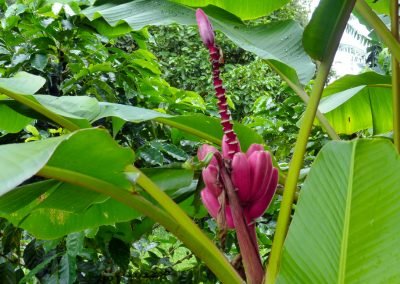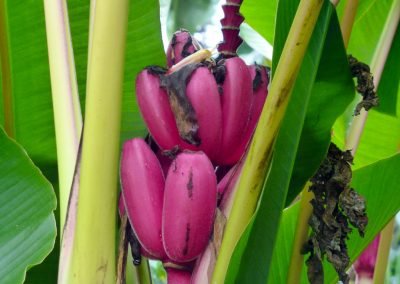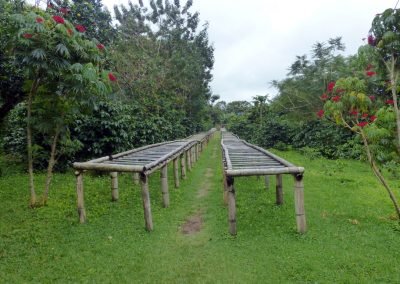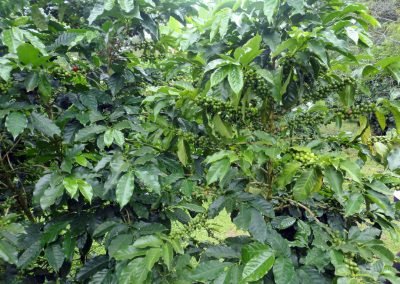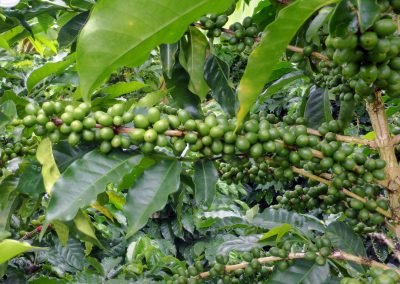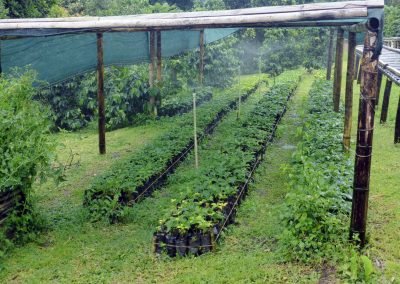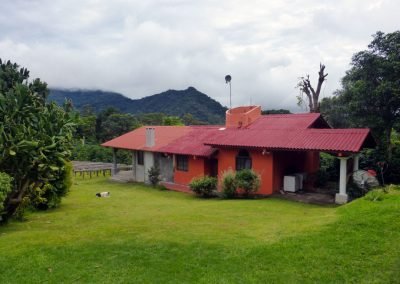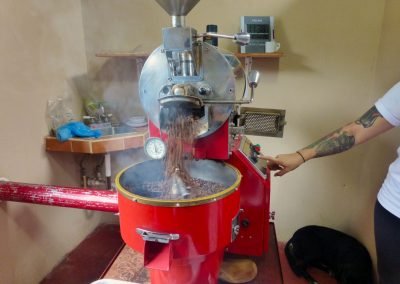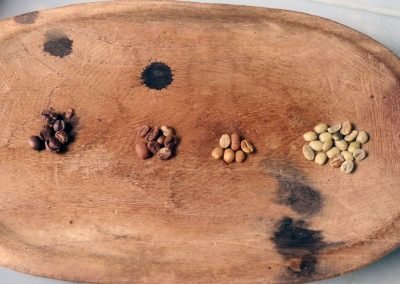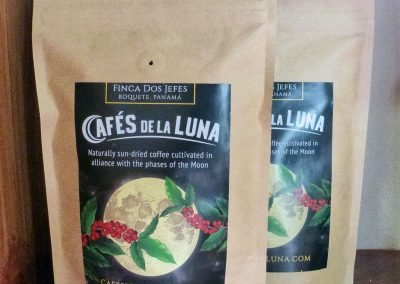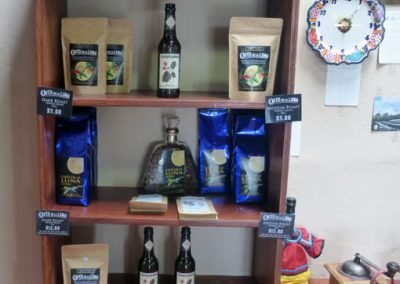Senior Nomad Budget Travel
Easy, Safe, Fun!Finca Dos Jefes Coffee Tour, Boquete Panama

Finca Dos Jefes (Farm of Two Bosses) in Boquete, Panama offers a fabulous coffee tour. I love coffee and I love learn-how-it’s-made tours. This place is top-notch in both of these basic categories. I rate it off-the-charts excellent for organic farming, fair/direct trade, top wages for farm workers, quality of product, community involvement, and fascinating educational tour value.
All the coffee grown here is Arabica, not Robusta. There are many differences — taste, plant hardiness, where cultivated, caffeine content, price, sugar content, just to name a few. Arabica is generally considered the better flavor for discerning coffee drinkers. (Click here for a short summary of the differences.)
Coffee cherry processing
We started our tour learning about the anatomy of a coffee bean. We tasted a ripe coffee cherry and discovered inside a small bean covered in two layers. The outer layer is sticky mucilage and underneath that is a paper thin parchment layer.
But now here’s where it gets really interesting. Nearly all coffee plantations will do one of two things. If they don’t have their own processing facilities, they’ll simply sell the bags of red cherries to someone else. So all the coffee from lots of farms gets combined and unique identity is lost.
If a farm is big enough to do their own processing, the odds are overwhelming that they’ll use a water method to do it. That uses lots of water to wash the fruit and sticky layer off and ovens to dry the inner bean. And more often than not, the water with the fruit discards is dumped straight back into the local river. This is ecologically damaging to the river.
Some farms do manage to save the bigger portions of the fruit to use for other purposes. But, if the farm is not organic, then it’s this outer cherry that contains the highest concentrations of pesticides and other chemicals. Not a comforting thought.
Organic, sun dried cherries
At Finca Dos Jefes, there are two really important differences. First, the farm is 100% organic. So no chemicals sprayed, no artificial fertilizers. Never! Second, they sun dry the whole cherries! This is a very labor intensive process that can take 6 to 8 weeks. The cherries are spread out on elevated bamboo racks that allow for air flow. They are raked and turned often. And they are carefully covered whenever it rains.
Below you can see the drying racks. Since it wasn’t harvesting season, I had to use my imagination!

When dry, you end up with a cherry that looks sort of like a firm round dried raisin.
One advantage of this method is that you avoid using precious water resources and don’t pollute by dumping discarded fruit. But there is an amazing taste advantage too. The inner coffee bean actually absorbs the sweetness and natural compounds from the outer fruit.

What is cascara?
These sun dried cherries are then processed mechanically using large rollers. This separates the dried outer fruit from the inner green beans. Both are collected. The green beans are then exported after this step. When green they have a much longer shelf-life than roasted beans. Plus, they can then be roasted as desired by different customers.

However, nothing from the sun-dried cherries is wasted. The dry outer fruit can be used to brew a herbal tea called Cascara. This tea used to be considered “poor man’s coffee”. Locals would drink it because they couldn’t afford brewed coffee from the beans – those were reserved for export.
But now the demands of gourmet coffee aficionados have turned cascara into a highly valuable commodity. You may see this flavorful fruity tea offered in high-end specialty coffee shops. Plus even the breweries are getting into the act. In an ongoing search for creative specialty brews, they’re making beer from cascara! Even more reasons why sticking with coffee from an organic farm is critically important. Click here for more details on Cascara.
What about controlling bugs?
The main problem they have here is the coffee berry borer beetle. The female bores a whole in the cherry and lays eggs inside the inner bean. And of course, you don’t want those beans in your harvest. But it’s way to time consuming for the pickers to examine every cherry! This is why some farms spray pesticides. But not at Finca Dos Jefes. Instead, all the picked cherries are first placed in a bucket of water. The bored ones float. They are simply skimmed off and then burned to prevent hatching of more beetles. The remaining good beans head for the drying racks.
But that’s the easy part. Over the several months of harvesting, some cherries inevitably end up on the ground. Plus dead leaves and other debris. This material could also contain beetle eggs which would hatch, resulting in an even bigger bug problem next year. So at Finca Dos Jefes, the pickers are hired for an extra couple months after the harvest is completed. They diligently go up and down all the rows and in-between all the coffee trees, picking up all debris from the ground. Although quite labor intensive, it is the best way to keep the bug population down to an acceptable minimum without using chemicals.
In tune with the moon
You may have noticed from the header photo that the name of the coffee brand at Finca Dos Jeffes is Cafés de La Luna (Coffees of the Moon). So what does the moon have to do with coffee? Well, in addition to being organic, they also do all their farm work based on a lunar calendar, not the standard 12-month calendar.

This is a time honored proven tradition that produces optimum results. It’s really not far-fetched when you think about it. We all know that phases of the moon control tides and the effects are even more pronounced (high or low) at new moon and full moon. The moon has a similar effect on the sap in the trees. Thus there are best times to prune, best times to plant, to harvest, etc. – all in tune with the moon.
Dark roast vs light roast
Of course there’s loads more roast variations, you’ll see them all on the shelf. But I learned some facts I hadn’t known before.
The darker the roast, the more “sins” are covered up. So if the coffee is not the best flavor or quality, or you want to bulk up your product with cheaper Robusta beans, then doing a dark roast will hide these flaws and produce a usable result. The dark roast is actually burning out the individual differences and flavor nuances of the beans.
For me, the most telling was the fact that all competitions and official taste-testing are conducted using a light roast. That’s because it’s the most revealing. Nothing can hide in a light roast. The true flavor and quality of the beans will be readily apparent.
Roasting our own to take home
Of course, we finished the tour with taste-testing some fresh brewed coffee. Delicious! I was very impressed with how fruity and almost sweet the coffee tasted, even when drinking it black. This is the direct result of the slow sun-drying method.
We had one final surprise treat… we got to roast our own coffee! We weighed out the beans, put them in the hopper and down they went into the spinning hot cylinder. Our guide supervised, but we all took turns doing different steps. It was quite interesting to take samples and see how the beans changed during the roasting process. And the smell was very enticing.
Best of all, this freshly roasted coffee was quickly packaged up. Each of us got a sample size bag to take home. Yum!
Should you store coffee in the fridge or freezer?
OK, I just had to know. I’ve read articles that say never ever store your coffee in the fridge or freezer. And I’ve read other articles that say it’s perfect for preserving the freshness and flavor of your beans. So what does the tour guide expert at Finca Dos Jefes have to say about this?
From our perspective the freezer is the way to go. Whole bean coffee will have an optimum freshness of 2½ weeks. In that time it’s best to store at room temperature in an air tight container.
Whatever is not consumed after 2½ weeks can then be stored in the freezer. Refrigerators have too much humidity and cross contamination with other foods.
If you are interested in a fun informative morning or afternoon activity, I highly recommend the Finca Dos Jefes tour. They’ll even pick you up in Boquete and deliver you back after the tour. Click here to read more and book.
P.S. No I don’t get anything for recommending them. I simply enjoyed the tour so much that I wanted to write it up. Enjoy!
(Click on any photo to open light-box and browse full-size images.)




